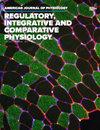Zinc-chelating BET bromodomain inhibitors equally target islet endocrine cell types
IF 2.2
3区 医学
Q3 PHYSIOLOGY
American journal of physiology. Regulatory, integrative and comparative physiology
Pub Date : 2024-04-15
DOI:10.1152/ajpregu.00259.2023
引用次数: 0
Abstract
Inhibition of the bromodomain and extraterminal domain (BET) protein family is a potential strategy to prevent and treat diabetes; however, the clinical use of BET bromodomain inhibitors (BETi) is associated with adverse effects. Here, we explore a strategy for targeting BETi to β-cells by exploiting the high zinc (Zn2+) concentration in β-cells relative to other cell types. We report the synthesis of a novel, Zn2+-chelating derivative of the pan-BETi (+)-JQ1, (+)-JQ1-DPA, in which (+)-JQ1 was conjugated to dipicolyl amine (DPA). As controls, we synthesized (+)-JQ1-DBA, a non-Zn2+-chelating derivative, and (-)-JQ1-DPA, an inactive enantiomer that chelates Zn2+. Molecular modeling and biophysical assays showed that (+)-JQ1-DPA and (+)-JQ1-DBA retain potent binding to BET bromodomains in vitro. Cellular assays demonstrated (+)-JQ1-DPA attenuated NF-ĸB target gene expression in β-cells stimulated with the pro-inflammatory cytokine interleukin 1β. To assess β-cell selectivity, we isolated islets from a mouse model that expresses green fluorescent protein in insulin-positive β-cells and mTomato in insulin-negative cells (non-β-cells). Surprisingly, Zn2+-chelation did not confer β-cell selectivity as (+)-JQ1-DPA was equally effective in both β- and α-cells; however, (+)-JQ1-DPA was less effective in macrophages, a non-endocrine islet cell type. Intriguingly, the non-Zn2+-chelating derivative (+)-JQ1-DBA displayed the opposite selectivity, with greater effect in macrophages compared to (+)-JQ1-DPA, suggesting potential as a macrophage-targeting molecule. These findings suggest that Zn2+-chelating small molecules confer endocrine cell selectivity rather than β-cell selectivity in pancreatic islets and provide valuable insights and techniques to assess Zn2+-chelation as an approach to selectively target small molecules to pancreatic β-cells.锌螯合BET溴链抑制剂同样靶向胰岛内分泌细胞类型
抑制溴基底域和胞外基质域(BET)蛋白家族是预防和治疗糖尿病的一种潜在策略;然而,BET溴基底域抑制剂(BETi)的临床应用与不良反应有关。在这里,我们利用β细胞相对于其他细胞类型的高锌(Zn2+)浓度,探索了一种将 BETi 靶向β细胞的策略。我们报告了泛 BETi (+)-JQ1 的新型 Zn2+ 螯合衍生物 (+)-JQ1-DPA 的合成,其中 (+)-JQ1 与二环戊二烯胺 (DPA) 共轭。作为对照,我们合成了不螯合 Zn2+ 的衍生物 (+)-JQ1-DBA 和螯合 Zn2+ 的非活性对映体 (-)-JQ1-DPA。分子建模和生物物理实验表明,(+)-JQ1-DPA 和 (+)-JQ1-DBA 在体外仍能与 BET 溴域有效结合。细胞实验表明,(+)-JQ1-DPA 可减轻受到促炎细胞因子白细胞介素 1β 刺激的 β 细胞中 NF-ĸB 靶基因的表达。为了评估β细胞的选择性,我们从一种小鼠模型中分离出了胰岛,这种模型的胰岛素阳性β细胞表达绿色荧光蛋白,而胰岛素阴性细胞(非β细胞)表达 mTomato。令人惊讶的是,Zn2+-鞘化物并没有赋予β细胞选择性,因为(+)-JQ1-DPA对β细胞和α细胞同样有效;然而,(+)-JQ1-DPA对巨噬细胞(一种非内分泌胰岛细胞类型)的效果较差。耐人寻味的是,非 Zn2+ 螯合衍生物 (+)-JQ1-DBA 显示出相反的选择性,与 (+)-JQ1-DPA 相比,(+)-JQ1-DPA 对巨噬细胞的作用更大,这表明它具有作为巨噬细胞靶向分子的潜力。这些发现表明,Zn2+-螯合小分子在胰岛中具有内分泌细胞选择性,而不是β细胞选择性,并为评估Zn2+-螯合作为一种选择性靶向胰岛β细胞的小分子的方法提供了有价值的见解和技术。
本文章由计算机程序翻译,如有差异,请以英文原文为准。
求助全文
约1分钟内获得全文
求助全文
来源期刊
CiteScore
5.30
自引率
3.60%
发文量
145
审稿时长
2 months
期刊介绍:
The American Journal of Physiology-Regulatory, Integrative and Comparative Physiology publishes original investigations that illuminate normal or abnormal regulation and integration of physiological mechanisms at all levels of biological organization, ranging from molecules to humans, including clinical investigations. Major areas of emphasis include regulation in genetically modified animals; model organisms; development and tissue plasticity; neurohumoral control of circulation and hypertension; local control of circulation; cardiac and renal integration; thirst and volume, electrolyte homeostasis; glucose homeostasis and energy balance; appetite and obesity; inflammation and cytokines; integrative physiology of pregnancy-parturition-lactation; and thermoregulation and adaptations to exercise and environmental stress.

 求助内容:
求助内容: 应助结果提醒方式:
应助结果提醒方式:


